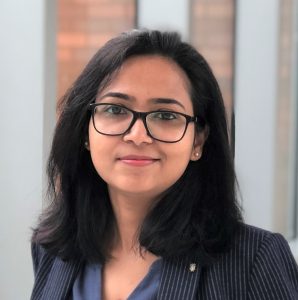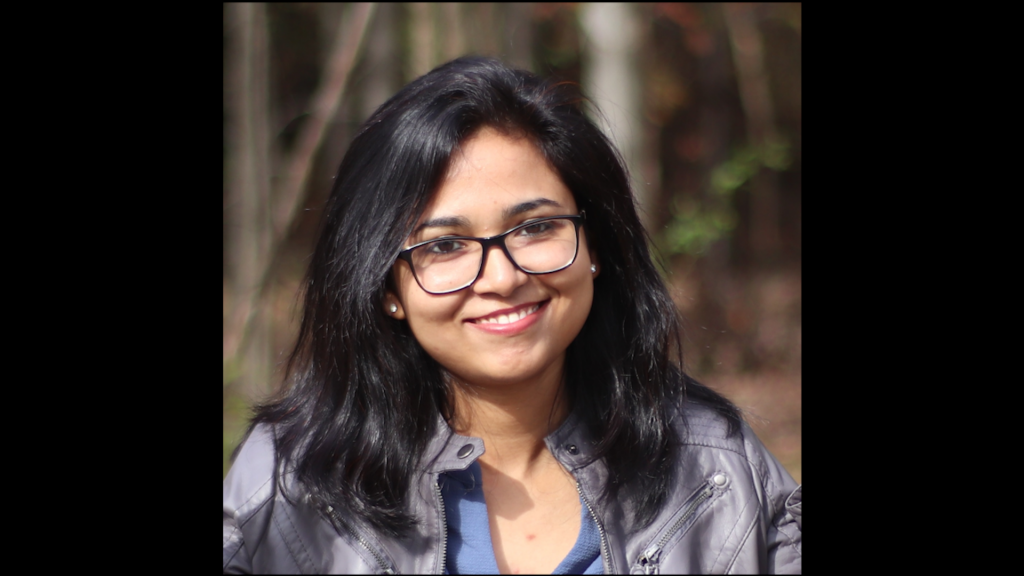We’re taking time to get to know the members of the GSA’s Early Career Scientist Committees. Join us to learn more about our 2020 early career scientist advocates.

Nashrah Ahmad
Communication & Outreach Subcommittee
Kent State University
Research Interest
Osteoarthritis (OA) is the most common form of joint disease in the world and a leading cause of disability. This disease is characterized by the breakdown of cartilage in the joints. Currently, there is no cure for OA and existing therapies only provide temporary relief from pain, making joint replacement therapy the ultimate option for an OA patient. As a result, there is a need to develop a therapeutic agent for the treatment of OA.
Nitric oxide is established as one of the major inflammatory mediators in OA and drives many pathological changes during the development and progression of OA. Synthesis of nitric oxide is catalyzed by the inducible enzyme nitric oxide synthase (iNOS), making this enzyme an attractive therapeutic target for the treatment of OA. During my research, I screened a number of small molecules for their protective effects in OA and identified a molecule called peretinoin, which inhibited the production of nitric oxide in cartilage cell culture. Peretinoin also inhibited the expression of iNOS in cartilage explant culture and prevented the breakdown of the cartilage matrix in a mouse model of OA, indicating that peretinoin could be a potential drug for OA treatment in the future.
As a PhD-trained scientist, you have many career options. What career paths interest you the most?
The PhD program at Kent State University provided me with a solid education in cell biology and genetics, along with rigorous training in critical thinking and experimental design. However, I feel that a PhD is much more than just research training, as the program imparted me with various universal skills that can be applied outside academia.
During my studies, I realized that the aspect of scientific research that I enjoy most is scientific writing. I have enjoyed different types of writing, whether writing manuscripts, abstracts, theses, or my dissertation. My friends, colleagues, and supervisors often approached me for editing, proofreading, and polishing their manuscripts, and I was more than happy to help. At that time, I was not aware of the medical writing profession; it was only last year when I participated in a science communication competition that I was introduced to the realm of science communication and medical writing. The moment I came to know about the medical writing industry, something inside me clicked. Medical writing entails developing manuscripts, abstracts, posters, and slide decks according to a client’s requirements, and ensuring consistency and quality of all the documents developed. I realized that this is exactly what I want to do in the future, as in this profession I could leverage my two strengths: a strong scientific background and a knack for writing.
It was very encouraging to know that by transitioning to medical writing, I could not only retain my passion for science by keeping abreast of advances in different therapeutic areas, but would also experience fulfillment by contributing to the progression of bench- to-bedside research. After I decided to become a medical writer, I joined several medical writing organizations to know more about this field, and the more I learned, the more I became sure that the medical writing industry would be a perfect fit for me and my skill set. Thus, I would love to work as a medical/scientific writer, as this career path is an ideal amalgamation of my love for science and my writing skills and will give me the joy of doing what I love.
In addition to your research, how else do you want to advance the scientific enterprise?
I remember reading an article about Dolly, the first cloned mammal, as a kid, and the level of excitement that I felt about the prospect of cloning an entire animal from a single cell was mesmerizing. Unfortunately, only the fanciest techniques and revolutionary scientific discoveries catch the attention of the media, and so the public remains unaware of the numerous new discoveries that are published every day in esoteric science journals, which have a minuscule readership. To spread the word as far as possible, I advocate spreading scientific news and discoveries via social media and science podcasts, as they can be an excellent means to bridge the gap between the scientist community and the general public.
I strongly believe that we scientists should not miss the social media bandwagon and must utilize all social media platforms to present our research in interesting ways, as well as expand the scope of our research by getting input from the public. Our responsibility as scientists is to communicate the importance of our research to the public in any way possible, be it through Twitter or other social media platforms. Such outreach activities would be particularly useful for young inquisitive minds. Many young kids are extremely enthusiastic about science; however, there aren’t many opportunities where they get a chance to interact with scientists and see scientific approaches to solving problems.
As a leader within the Genetics Society of America, what do you hope to accomplish?
As a member of the Communication and Outreach Subcommittee, I look forward to making scientific discoveries more accessible among researchers and to help in promoting the public’s understanding of science. I feel that scientists struggle to communicate key recent developments in genetics, particularly advanced techniques such as CRISPR/Cas9 gene editing. As a community, we need to devise simpler and more effective ways of communicating science to a non-scientific audience. Events like TED talks and Three-Minute Thesis competitions are good platforms to bridge the gap between scientists and the general public, but additional outreach programs can further support efforts to fill this gap. On this committee, I hope to interact with people from different scientific backgrounds and, together with fellow committee members, contribute to crafting informative outreach articles. My main focus will be to make sure that accurate scientific information is conveyed in an engaging manner that can be understood by the target audience.
Previous leadership experience:
Student representative- University Scholarships & Awards Committee, Northeast Ohio Medical University
Graduate student mentor- Kent State University
Graduate Teaching assistant- Kent State University
Connect with Nashrah on LinkedIn.































